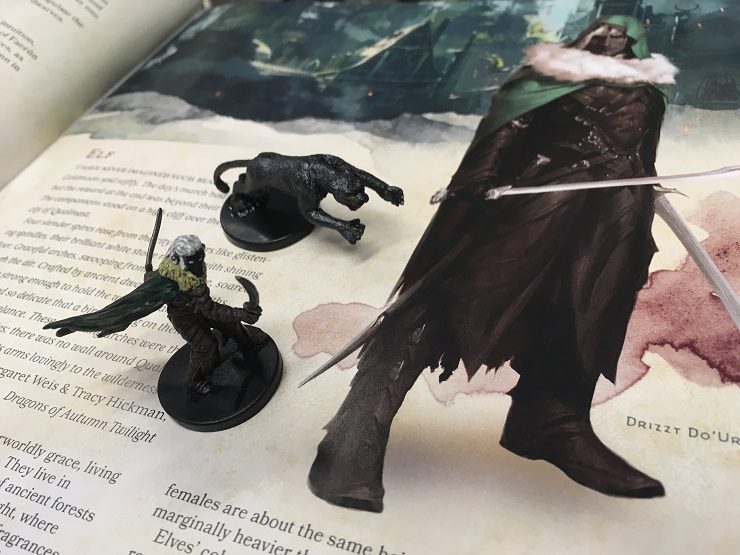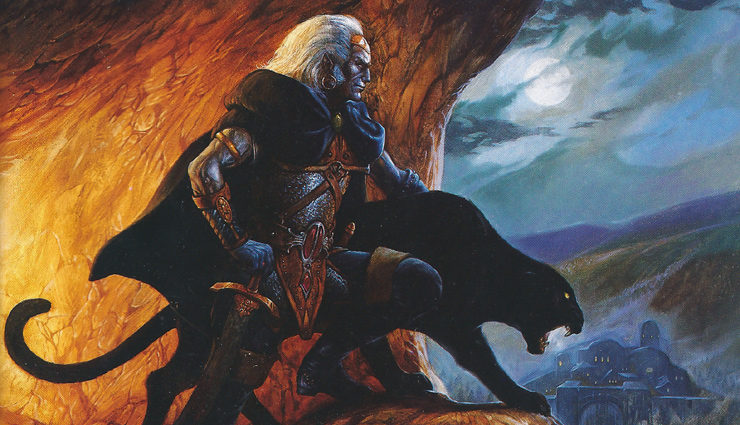R. A. Salvatore is an author I can’t quite shake. Let me explain.
I was part of TSR’s target demographic—I think—back when his illustrious Dark Elf Trilogy came out 25+ years ago. I saw the covers of Exile and Sojourn first, with their fiery cave walls, strange cloaks, some grim-faced elf-dude with long white hair…and an awesome black panther! This was a long time ago when a whole lot of novel and D&D game book covers were painted by fantasy art luminary Jeff Easley (among others). I was immediately drawn to the central figure. I had questions. Who was this guy? Hey, has he got a scimitar?! What’s with the crazy pirate earrings? Why the skullcap? Is that panther his friend? Where is this?!
Fast forward some fifteen years later: I published a novel for Wizards of the Coast, penned a second, wrote for both Dragon and Dungeon magazines, and contributed to a few RPG books. And all these fantasy projects—humble as they were—came about, in part, due to encouragement I received from R. A. Salvatore directly. Can I tell the tale?

Anyone who’s seen my name on Tor.com probably knows that I’m a Tolkien nut. And yeah, as a kid my head was filled to the brim with Rankin/Bass goblins, Glenn Yarbrough’s Middle-earth tunes, and Ralph Bakshi’s terrifying ringwraiths. But I didn’t really become a book fan of the Tolkien’s work until some years later.
Before that, for me, came the stories of R. A. Salvatore. And I wouldn’t change a thing about how it all went down.
I was already a reader of the Dragonlance saga, but hadn’t paid much heed to the Forgotten Realms. Then came Homeland, the mass market that gave us the origin story of Drizzt Daermon N’a’shezbaernon, aka Drizzt Do’Urden. I later learned that this legendary dark elf already been introduced in the Icewind Dale Trilogy (published prior to Homeland, though it takes place chronologically later)—but not even as its chief protagonist. Rather, he was just one member of its gang of heroes.
Drizzt was part sidekick, part mentor, for Wulfgar, a young and brash human of the Icewind Dale’s barbarian tribes.
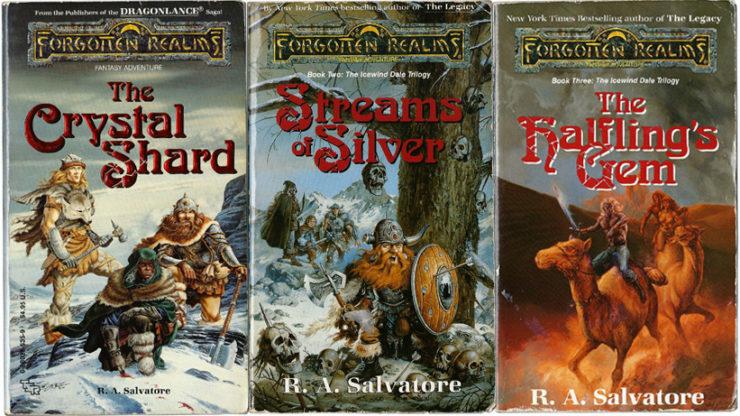
Not so much now. Now, Drizzt is the central character in the Dark Elf saga.
Sure, all of Salvatore’s books in stores now have slick Todd Lockwood covers (and they are fantastic and probably more true to the characters), but I’m going to credit Easley first for drawing me in, along with a whole bunch of my peers. The drow—the wicked dark elves of D&D, with their obsidian black skin and white hair—were still rather new then. Bob Salvatore didn’t invent the drow—a dash of real-world folklore and the creative mind of Gary Gygax did that—but he absolutely popularized them. He put them (and himself) on the map, and it was he who breathed colorful, if treacherous, life into them.
I loved—no, still love—the Dark Elf Trilogy. It reads differently to me now as an adult, sure, but it’s infinitely re-readable. Especially Homeland. Most of the trilogy takes place in the Underdark, the vast, monster-filled labyrinth far beneath the planet of Toril. Drizzt is a young noble in a city of dark elves, born to a family who will immediately offer his infant (and more importantly, male) life to the Spider Queen, Lolth. Only the murder of one of his older brothers by another spares him from the sacrificial blade—and sets the stage for one of the most enduring characters in contemporary fantasy. It’s not until the final book, Sojourn, that Drizzt finally reaches the sunlit surface world, becomes a ranger, and meets his future companions in the arctic region known as Icewind Dale.
Drizzt was still shiny and new, the perfect character for any fantasy-loving reader to latch onto: the heroic outlier, with his whirling scimitars, his people’s evil reputation to overcome, and his best friend beside him—the magical six-hundred-pound panther, Guenhwyvar.
And there were, of course, plenty more Drizzt books to come, including some spin-offs involving various allies and erstwhile foes. Over the years, the very concept of a dual-wielding drow elf ranger has become a caricature, an infamous trope, in the role-playing game world. But even that’s evolved over time; the alleged swarm of so-called Drizzt clones at gaming tables led to endless message board rants, but it seems to me that the fans were always more numerous than the haters, and TSR, then WotC, responded with various sourcebooks relating to the dark elves.
He’s even been parodied in other corners of the game world—like Zz’dtri in the webcomic The Order of the Stick or Vzzl Vr’tzzl in the card game Munchkin Gloom.
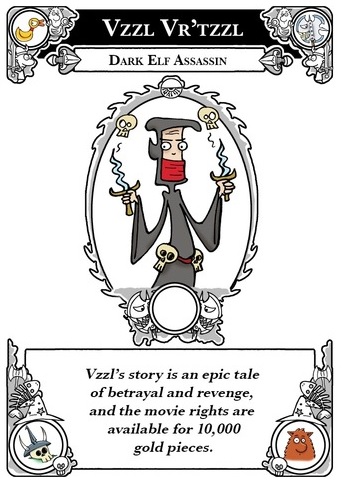
So, the first time I met Bob Salvatore was in a Waldenbooks in Newport, Rhode Island, and he was there to sign copies of The Legacy, which (1) marked the first hardcover TSR ever produced, (2) was a fast New York Times Best Seller, and (3) continued the saga of Drizzt after the events of the Icewind Dale Trilogy, but now benefited from all the new lore dreamed up in the Dark Elf Trilogy.
It was a respectable little crowd that turned out to meet him, nothing like the ginormous lines you’ll find now at GenCon when Salvatore shows up for a signing. And, of course, it was a memorable experience for me. For one, who were all these other people who read the same books as me?! This was mind-boggling for a kid at the time, especially since plenty of them were adults. D&D itself still had a stigma attached to it, at least where I came from, and supposedly only nerds read tie-in fiction.
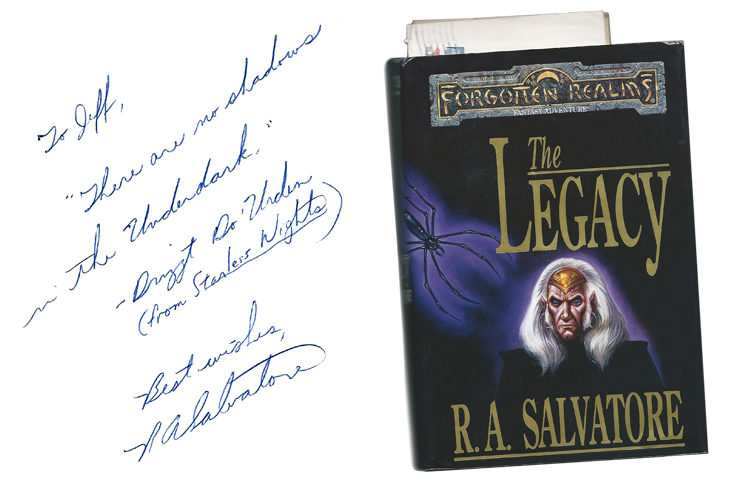
But the whole experience was also great because Bob’s an approachable guy; he talks the gamer talk and walks the gamer walk. It’s fun to recall now: I went to that signing early, and while I was loitering in the science fiction section to kill time, I overheard Bob (who was also early) ask the store clerk if they were expecting any kind of turnout.
Cut to a couple of decades later—not only do you get long lines at Author’s Alley book signings, you get huge Drizzt and Lolth the Spider Queen sculptures carted around to conventions.
Anyway, on that same day in the early 90s, with my hard-earned and very limited money I also bought the Menzoberranzan boxed set (ahh, back when they still made boxed sets regularly), which detailed the city of Drizzt’s origin. Now Dungeon Masters and players alike could fill their campaigns with feuding noble houses, evil matron mothers, and vile plots, but this time with actual maps of the city and ready-made NPCs. Geek that I was, I already owned (and had read through a gazillion times) Ed Greenwood’s The Drow of the Underdark, which had come out the year before.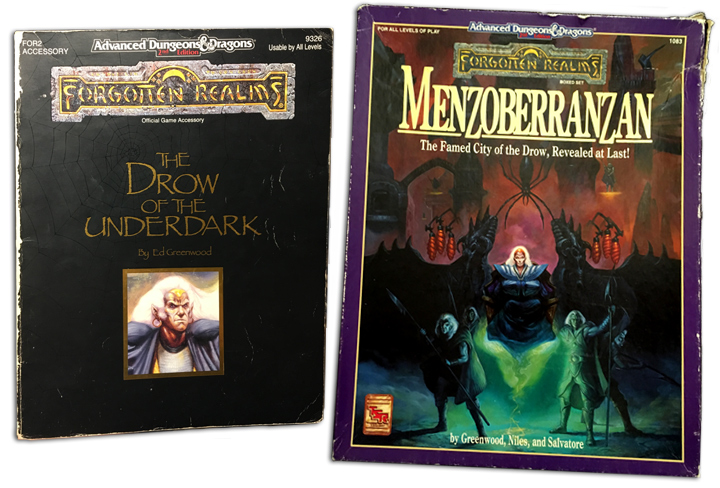
That had been the first game book in 2nd Edition Advanced Dungeons & Dragons to introduce drow culture, along with tons of drow- and spider-themed spells and magic items. You know, like your standard-issue whip of fangs for enthusiastic Lolth’s priestesses, your fire-resistant piwafwi (the drow version of the ol’ cloak of elvenkind), and the always-handy light pellets (good for temporarily blinding the dark-loving drow). But there were also lesser known toys like the wand of viscid globs. Those things were nasty!
It also revealed the names and symbols of all the Menzoberranzan noble houses and some cool phrases in the Deep Drow language. Like:
Nindyn vel’uss kyorl nind ratha thalra elghinn dal lil alust. (Those who watch their backs meet death from the front.)
Never mind that I was never able to use much of this stuff in my nerdy Stranger Things-but-in-the-90s D&D group. But that’s okay—I still had innumerable hours of thinking up drow-based adventures ahead, whether I’d use them or not. More than half of the job of being a regular DM is just dreaming up encounters, making maps, and working up stats…not actually running the game.
But I digress. Time passed, and as more R. A. Salvatore novels appeared, so did the demand for more drow among gamers and readers. At least I assume it was demand driving the output; the D&D market sometimes felt rather saturated with dark elf-, spider-, and Lolth-filled products. And I guess, why not? The Underdark makes a fascinating backdrop, and the appearance of the drow in any adventure—usually as villains, but sometimes as allies—makes for an exotic plot device.
And of course, they don’t all have to fit the mold of chaotic good male drow fighter/barbarian/rangers with dual-wielding feats and character builds (okay, so that was Drizzt with 3rd Edition stats—he’s existed now in four incarnations of the game). Other authors have written some inventive and not-so-straightlaced drow protagonists in the wake of Salvatore’s success. Dark elves of the heroic, anti-heroic, and villainous varieties, like those in the Starlight and Shadows novels of Elaine Cunningham or the six installments of the War of the Spider Queen series, wherein each novel was written by a different author: Lisa Smedman, Richard Lee Byers, Thomas M. Reid, Richard Baker, Philip Athans, and Paul S. Kemp.
As for the thousands and thousands of gamers in their own homebrew campaigns? Whether using published adventures or inventing their own, there have always been different ways to use the drow. But yeah, they’re usually the bad guys.
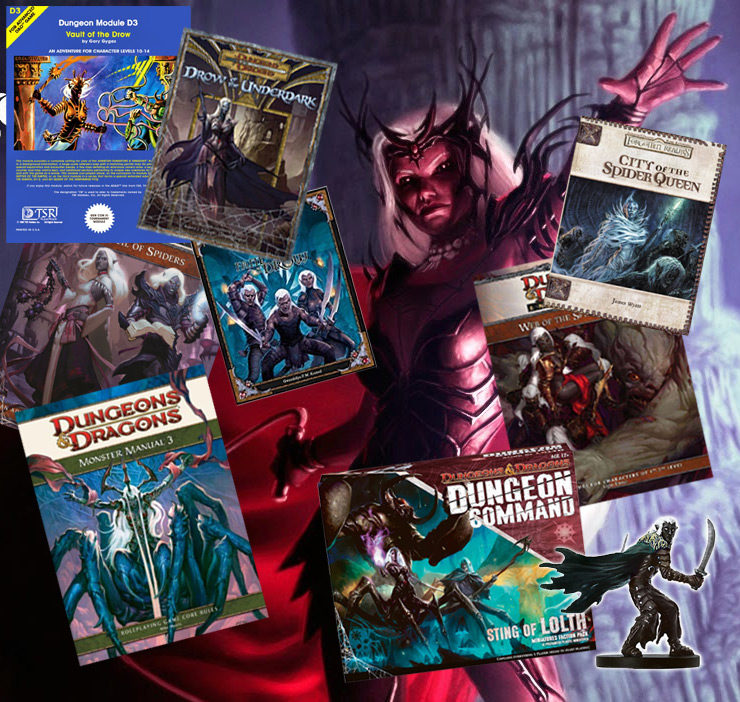
Still, Drizzt Do’Urden remains iconic—introspective, stat-free, and, sure, sometimes a little too powerful. But his soft spots, his flaws, and his vulnerabilities have always revolved around his friends and the choices he makes, not his whirling scimitars. At the end of the day, I remember Drizzt’s principles, and his struggles to retain them in the face of adversity, more than anything else. I’m the type of fan who favors the dialogue, the relationships, and the internal strife over even the battles (of which there are many).
Not to mention all his very interesting friends! Drizzt doesn’t carry the books alone. First, there is Guenhwyvar, who spends most of her time on the Astral Plane, but who Drizzt can call forth with his figurine of wondrous power (an item out of old D&D rules) for up to 12 hours in a 48-hour cycle. The fact that he often summons her just for her company and not only as a battle aid is delightful. In Exile there was Clacker (a hooked horror—sort of!) and Belwar (a maimed svirfneblin gnome; in Sojourn there was Montolio (the blind human ranger who mentored Drizzt), and the eventual companions of Mithral Hall—Bruenor the dwarf fighter, Cattie-brie the human fighter, Wulfgar the human barbarian, and Regis the halfling thief. All part of Drizzt’s adventuring party, you might say.
Also—sorry, haters—there is an illustration of Drizzt in the 5th Edition Players Handbook under the entry for Elf. As if this renegade drow was the quintessential elf PC. I mean, he’s not, but the mere sight of him sends a good message to a D&D newbie: you can be anything you want in this game: outlandish, formidable, heroic. That’s as worthy a goal now as it was when Drizzt first came on stage.
So anyway, after I read The Legacy, 15-year-old me wrote a letter to its author because I felt the need to tell him what I thought about Drizzt, and what he meant to me personally. Most fantasy heroes seem to be defined by the enemies they vanquish, the people they save, or the places they go. Drizzt, for all his larger-than-life heroics and nefarious foes, is defined first by the thoughts he has. Which I know sounds sentimental, but man did that resonate with me as a moody teen. For one, Drizzt’s actions are driven by his morals in a very clear way. Sure, plenty of our favorite book characters make moral choices, but there’s something different about this one…we don’t just see him brood in silence as he watches over his adopted homesteads like some fantasy version of Batman (despite the brood-y original cover of Sojourn, above). We actually get inside his head and understand what he’s going through—in his own words.
See, with Homeland, Salvatore began a tradition I’ve noticed he’s carried into a lot of his books, even non-Drizzt ones. At the opening of each new section (Homeland has 5 parts) is a short essay describing the central character’s thoughts on a particular subject related to what’s going on in the plot, written as though it was a memoir. I’ve heard some readers complain about these, or describe Drizzt as whiny and emo, and I just shake my head. I feel bad for them, for being that jaded. Obviously these essays do work for a lot of people; they’ve made Drizzt an especially compelling character. These writings are reflective and intimate; to me, they provide a refreshing contrast to the grimdark sensibilities of a lot of today’s fantasy. When you consider how foreign and fantastical Drizzt’s life actually is, these written thoughts have a way of grounding you—you don’t have to defeat mind flayers and demons to relate to his thoughts about loss, guilt, or friendship.
In any case, my letter to Salvatore was sent by snail mail because I was a kid and email wasn’t quite so common yet. Just a few weeks later, he responded. And, well, I’d like to share it now, all these years later. You’ll notice I was (and often still am) interested in the spiritual associations of the character.
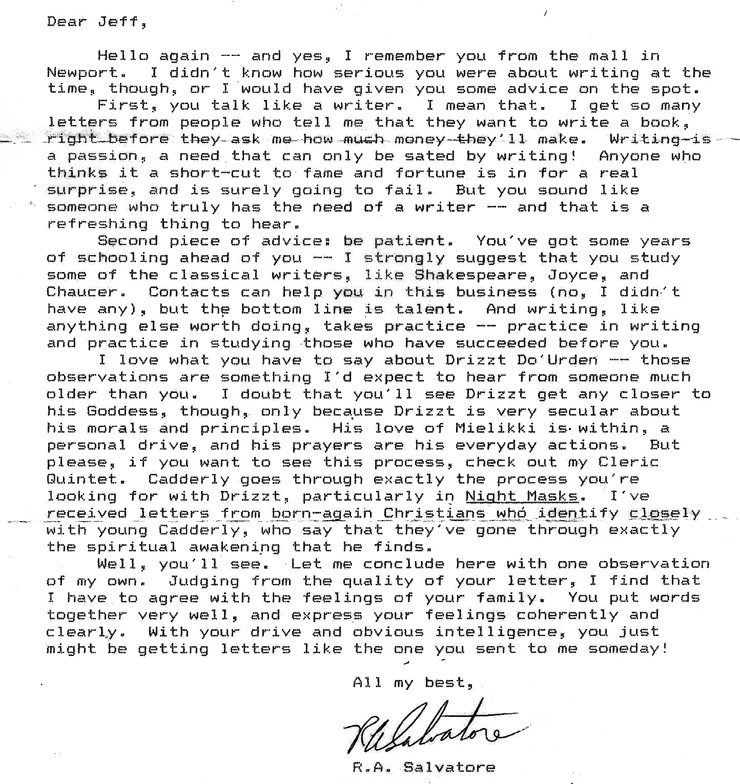
Needless to say, I was very encouraged by this, as I think any fan would be who received this kind of written response. Email is all well and good, but this letter is something I’ve always appreciated and held onto.
Now the series he mentions, The Cleric Quintent, was a five-book story I had already begun to read by then anyway. The primary character is Cadderly, a peace-loving and bookish young priest of Deneir (god of art and literature) who lives in a cloistered mountain library. He’s a far cry from the mighty warrior Drizzt. He’s got knowledge and wisdom but sucks in a fight, resorting to imaginative solutions to all his challenges. Yet he’s still beset with perilous adventures which come right to him. Luckily his girlfriend, Danica, is an ass-kicking monk and he’s also got the help of a pair of resourceful dwarf brothers, Ivan and Pickel Bouldershoulder. The series is a good time, and there’s a hell of a lot of heart and humor in it.
As with Salvatore’s others books, Wizards of the Coast would eventually redo the covers (more than once), but nostalgia wins me over, and so I still dig the Jeff Easley paintings best. Plus they’re just more colorful:
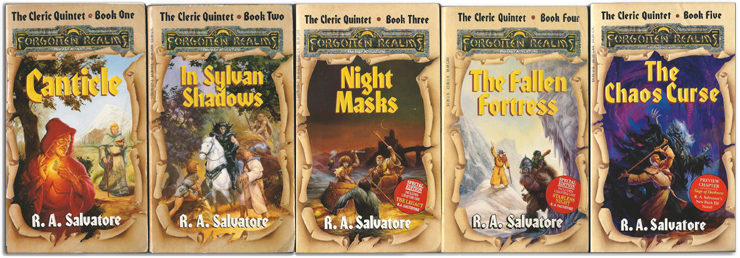
After writing these and a bunch more dark elf novels and short stories (and contributing to plenty of official D&D products), Salvatore did eventually break out into a new setting of his own outside of Wizards of the Coast. The world he made was Corona, and the first book was The Demon Awakens.
On the book tour for this first DemonWars novel, he stopped through the Borders Books in Novi, Michigan—where I worked the event. So that was our second meeting. I admit I was a bit wary of this DemonWars saga at first. Why? Not because Salvatore had left Drizzt behind for a while (he deserved the break), but because of how it started. The story begins with an orphaned young man who becomes an elf-trained ranger, then fights alongside his friends against a demon and a horde of goblins and giants. This seemed like all-too-familiar territory, particularly for Salvatore. Orc and goblin hordes are kind of his thing! I wanted something new.
But when you stay the course in The Demon Awakens, you find a whole bunch of clever new twists to the otherwise well-trodden fantasy archetypes. The character of Brother Avelyn, and the legacy he begins, has probably stayed with me the most, looking back. Even better, as the saga goes on, the very nature and complexity of the conflicts mature greatly.
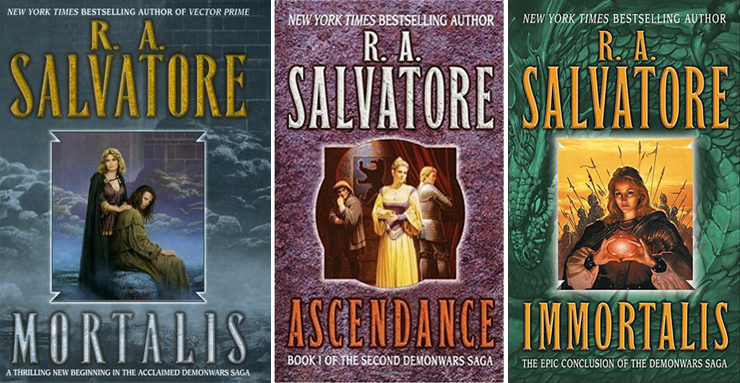
I remember writing to Bob again—this time by email—after reading Mortalis and Ascendance, because I was impressed at how thoroughly I’d been drawn in to the developing story of politics and religious corruption. This wasn’t Drizzt material by a long shot! And the character of Jilseponie, a peasant girl turned warrior turned queen turned grieving mother turned politician, struck me as one of the most believable characters in all of his books. Pony has to deal with some really grown-up shit in these books, but you know what? It works, and I was enthralled all over again. I almost wonder what teenage me would have thought of them…would I have appreciated the nuances? Maybe not.
All in all, Salvatore has produced something like ten or eleven books in the world of Corona—and oh yeah, a couple of Star Wars novels—even as he returned again to the Forgotten Realms and threw Drizzt under the bus a few times. (In a good way!) Say what you want about how he can’t be killed and how he can take on ten thousand orcs—Drizzt still has to go through the wringer each time; he suffers, and sometimes loses friends.
There have been some seriously crazy things happening in the Forgotten Realms over the years (I’m looking at you, Spellplague!), mostly due to the D&D game itself going through some turbulent edition change. For years I used to read every Drizzt book as soon as it came out, but I have to admit I haven’t been able to keep up with Drizzt as easily in more recent times—life interferes.
But I also can’t ever shake him, or his maker. I know I’ll go back again, and I suspect I won’t like everything I discover about what’s become of Drizzt. Wizards of the Coast advanced the timeline of the Forgotten Realms a hundred years now, so…things will change. Plus ça change, plus c’est la même chose. Such is life. At the same time, not having read all the Drizzt books to date means there’s always something to go back to.
Buy the Book
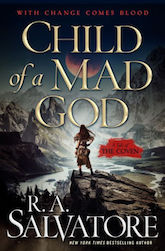

Child of a Mad God: A Tale of the Coven
So now we come full circle: Just this week, Child of a Mad God hits both brick-and-mortar and online stores, published by the company I now work for! This is Salvatore’s return to the world of Corona, but the story’s set in a region far removed from his Demon Wars books and seems to incorporate some crazy new ideas I look forward to discovering. In this world, gemstones and crystals are the source of magic, and young Aoleyn belongs to a coven of witches. There are barbarians, humans with misshapen heads, monster-occupied lochs, and demons. And also, some of those first-person essays I mentioned before—in this book they’re written by an exiled king, Aydrian, who factors heavily in the DemonWars Saga but whose story you don’t need to know to appreciate.
Should anyone reading this have even an inkling of interest, whether you’re familiar with Salvatore’s legacy of dark elves or not, know that you don’t need to start anywhere else. Start here…and then go back and meet Drizzt and Cadderly!
Finally, the few subsequent times I’ve run into Salvatore again or otherwise made contact with him, he claims to remember me from that original Waldenbooks book signing way back in the 90s. I’m still not sure I believe him, but he’s good people. Thanks again, Bob, if you’re reading this!
And you know, I never did find out why Jeff Easley painted Drizzt (quite a few times) with that gold skullcap on his head. But you know what? It doesn’t matter. The art first drew me in, and Bob kept me there. The kid in me never really left Icewind Dale, while the adult looks fondly back. Waiting to jump back in.
Top image: “Sojourn” by Jeff Easley
Jeff LaSala (who riffs on Tolkien and sometimes writes his own fiction) not only got many of his friends into R. A. Salvatore, he also helped made a Drizzt fan out of his wife. He even bought her an impractically large stuffed black panther once. Because Guenhwyvar!
